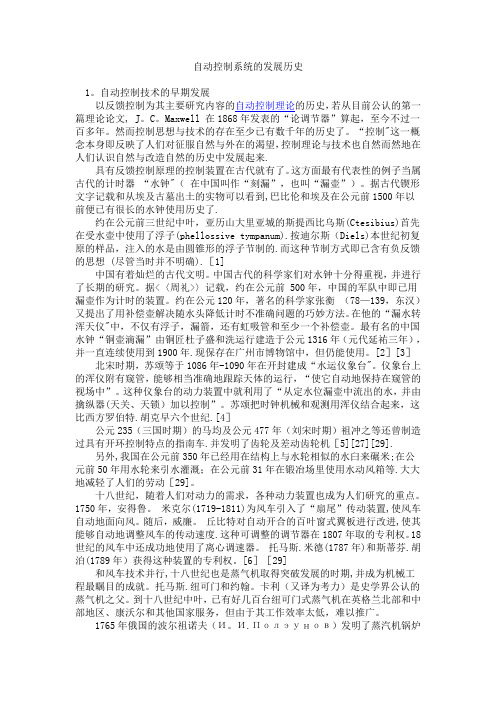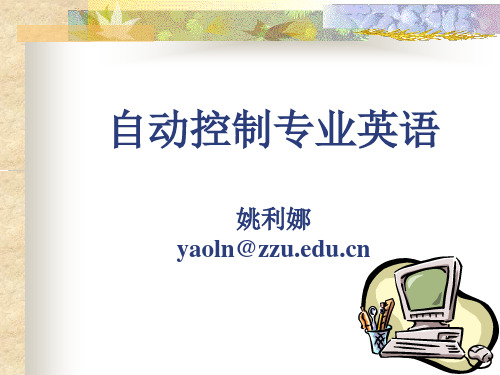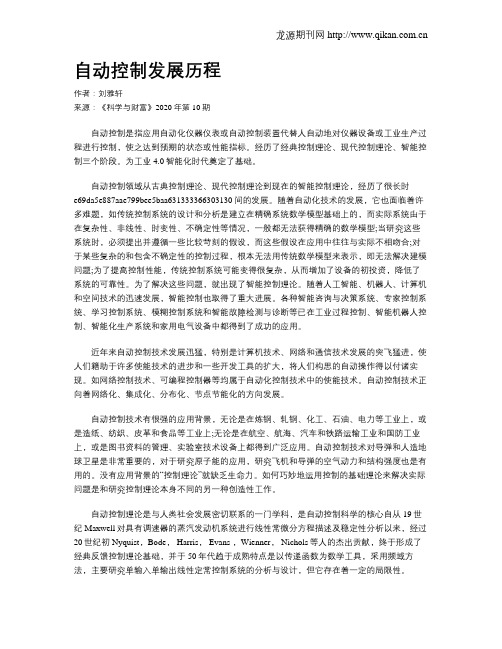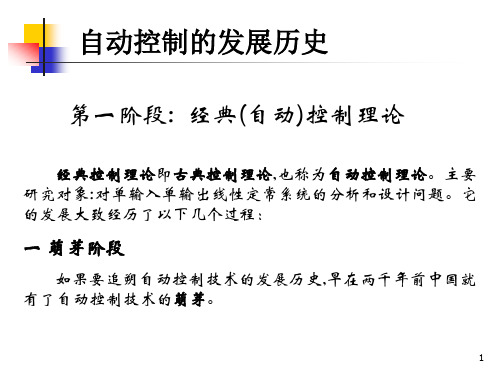自动化专业外文翻译--自动控制的发展历史
- 格式:docx
- 大小:35.76 KB
- 文档页数:8

自动控制系统的发展历史1。
自动控制技术的早期发展以反馈控制为其主要研究内容的自动控制理论的历史,若从目前公认的第一篇理论论文, J。
C。
Maxwell 在1868年发表的“论调节器”算起,至今不过一百多年。
然而控制思想与技术的存在至少已有数千年的历史了。
“控制"这一概念本身即反映了人们对征服自然与外在的渴望,控制理论与技术也自然而然地在人们认识自然与改造自然的历史中发展起来.具有反馈控制原理的控制装置在古代就有了。
这方面最有代表性的例子当属古代的计时器“水钟"(在中国叫作“刻漏”,也叫“漏壶”)。
据古代锲形文字记载和从埃及古墓出土的实物可以看到,巴比伦和埃及在公元前1500年以前便已有很长的水钟使用历史了.约在公元前三世纪中叶,亚历山大里亚城的斯提西比乌斯(Ctesibius)首先在受水壶中使用了浮子(phellossive tympanum).按迪尔斯(Diels)本世纪初复原的样品,注入的水是由圆锥形的浮子节制的.而这种节制方式即已含有负反馈的思想 (尽管当时并不明确).[1]中国有着灿烂的古代文明。
中国古代的科学家们对水钟十分得重视,并进行了长期的研究。
据<〈周礼>〉记载,约在公元前 500年,中国的军队中即已用漏壶作为计时的装置。
约在公元120年,著名的科学家张衡(78—139,东汉)又提出了用补偿壶解决随水头降低计时不准确问题的巧妙方法。
在他的“漏水转浑天仪"中,不仅有浮子,漏箭,还有虹吸管和至少一个补偿壶。
最有名的中国水钟“铜壶滴漏”由铜匠杜子盛和洗运行建造于公元1316年(元代延祐三年),并一直连续使用到1900年.现保存在广州市博物馆中,但仍能使用。
[2][3]北宋时期,苏颂等于1086年-1090年在开封建成“水运仪象台"。
仪象台上的浑仪附有窥管,能够相当准确地跟踪天体的运行,“使它自动地保持在窥管的视场中”。
这种仪象台的动力装置中就利用了“从定水位漏壶中流出的水,并由擒纵器(天关、天锁)加以控制”。

自动化历史及其专业发展自动化是一门涉及控制系统和计算机科学的学科,它的发展与工业革命密不可分。
本文将详细介绍自动化的历史发展以及该专业的发展趋势。
1. 自动化的起源自动化的起源可以追溯到古代。
古希腊的克特斯提出了一种使用水力来自动控制门的机械装置。
随着科学技术的进步,工业革命催生了自动化的发展。
18世纪末,英国的纺织工业中浮现了自动化的雏形,如约瑟夫·马歇尔的织布机。
19世纪末,电力的广泛应用为自动化的发展提供了基础。
2. 自动化的发展历程20世纪初,自动化开始在工业领域得到广泛应用。
自动化的核心是控制系统,通过传感器、执行器和控制器实现对工业过程的自动控制。
随着电子技术和计算机技术的发展,自动化的应用范围不断扩大。
20世纪50年代,数字计算机的浮现使得自动化控制系统更加灵便可靠。
20世纪60年代,控制理论的发展为自动化技术提供了更多的理论基础。
70年代,微处理器的浮现使得自动化控制系统更加小型化和高效化。
80年代,工业机器人的浮现进一步推动了自动化技术的发展。
3. 自动化专业的发展趋势随着信息技术的飞速发展,自动化专业也面临着新的挑战和机遇。
以下是自动化专业发展的几个趋势:3.1 智能化:人工智能和机器学习的发展为自动化技术注入了新的活力。
智能化的自动化系统能够根据环境变化自主调整和优化控制策略,提高系统的性能和效率。
3.2 互联网和物联网的融合:互联网和物联网的快速发展为自动化系统的远程监控和管理提供了便利。
通过互联网和物联网技术,可以实现对分布式自动化系统的集中控制和数据采集,提高系统的可靠性和可维护性。
3.3 自动化与生产线协同:自动化技术在创造业中的应用越来越广泛。
自动化与生产线协同可以实现生产过程的高效自动化,提高生产效率和产品质量。
3.4 自动化与可持续发展:环境保护和可持续发展是当今社会的重要议题。
自动化技术可以应用于能源管理、环境监测等领域,实现资源的合理利用和环境的保护。


自动控制发展历程作者:刘雅轩来源:《科学与财富》2020年第10期自动控制是指应用自动化仪器仪表或自动控制装置代替人自动地对仪器设备或工业生产过程进行控制,使之达到预期的状态或性能指标。
经历了经典控制理论、现代控制理论、智能控制三个阶段。
为工业4.0智能化时代奠定了基础。
自动控制领域从古典控制理论、现代控制理论到现在的智能控制理论,经历了很长时e69da5e887aae799bee5baa631333366303130间的发展。
随着自动化技术的发展,它也面临着许多难题,如传统控制系统的设计和分析是建立在精确系统数学模型基础上的,而实际系统由于在复杂性、非线性、时变性、不确定性等情况,一般都无法获得精确的数学模型;当研究这些系统时,必须提出并遵循一些比较苛刻的假设,而这些假设在应用中往往与实际不相吻合;对于某些复杂的和包含不确定性的控制过程,根本无法用传统数学模型来表示,即无法解决建模问题;为了提高控制性能,传统控制系统可能变得很复杂,从而增加了设备的初投资,降低了系统的可靠性。
为了解决这些问题,就出现了智能控制理论。
随着人工智能、机器人、计算机和空间技术的迅速发展,智能控制也取得了重大进展。
各种智能咨询与决策系统、专家控制系统、学习控制系统、模糊控制系统和智能故障检测与诊断等已在工业过程控制、智能机器人控制、智能化生产系统和家用电气设备中都得到了成功的应用。
近年来自动控制技术发展迅猛,特别是计算机技术、网络和通信技术发展的突飞猛进,使人们籍助于许多使能技术的进步和一些开发工具的扩大,将人们构思的自动操作得以付诸实现。
如网络控制技术、可编程控制器等均属于自动化控制技术中的使能技术。
自动控制技术正向着网络化、集成化、分布化、节点节能化的方向发展。
自动控制技术有很强的应用背景,无论是在炼钢、轧钢、化工、石油、电力等工业上,或是造纸、纺织、皮革和食品等工业上;无论是在航空、航海、汽车和铁路运输工业和国防工业上,或是图书资料的管理、实验室技术设备上都得到广泛应用。


1、 外文原文(复印件)A: Fundamentals of Single-chip MicrocomputerT h e sin gle -ch ip mi c ro co m p u t e r is t h e cu lm in at io n of b ot h t h e d e ve lo p me nt of t h e d ig ita l co m p u t e r a n d t h e i nte g rated c ircu it a rgu ab l y t h e to w mo st s ign if i cant i nve nt i o n s of t h e 20t h c e nt u ry [1].T h ese to w t yp e s of arch ite ct u re are fo u n d in s in gle -ch ip m i cro co m p u te r. S o m e e mp l oy t h e sp l it p ro gra m /d at a m e m o r y of t h e H a r va rd arch ite ct u re , s h o wn in -5A , ot h e rs fo l lo w t h e p h i lo so p hy, wid e l y ad a p ted fo r ge n e ral -p u rp o se co m p u te rs an d m i cro p ro ce ss o rs , of m a kin g n o l o g i ca l d i st in ct i o n b et we e n p ro gra m an d d ata m e m o r y as in t h e P rin c eto n a rch ite ct u re , sh o wn in -5A.In ge n e ra l te r m s a s in g le -ch ip m ic ro co m p u t e r is ch a ra cte r ized b y t h e in co r p o rat io n of all t h e u n its of a co mp u te r into a s in gle d e vi ce , as s h o w n in F i g3-5A-3.-5A-1A Harvard type-5A. A conventional Princeton computerProgrammemory Datamemory CPU Input& Output unitmemoryCPU Input& Output unitResetInterruptsPowerFig3-5A-3. Principal features of a microcomputerRead only memory (ROM).RO M is u su a l l y fo r t h e p e r m an e nt , n o n -vo lat i le sto rage of an ap p l i cat io n s p ro g ram .M a ny m i c ro co m p u te rs a n d m i cro co nt ro l le rs are inte n d ed fo r h i gh -vo lu m e ap p l i cat io n s a n d h e n ce t h e e co n o m i cal man u fa c t u re of t h e d e vi ces re q u ires t h at t h e co nt e nts of t h e p ro gra m me mo r y b e co mm i ed p e r m a n e nt l y d u r in g t h e m a n u fa ct u re of c h ip s . C lea rl y, t h i s imp l ies a r i go ro u s ap p ro a ch to ROM co d e d e ve lo p m e nt s in ce ch an ges can n o t b e mad e af te r m an u fa ct u re .T h i s d e ve l o p m e nt p ro ces s m ay i nvo l ve e mu l at i o n u sin g a so p h ist icated d e ve lo p m e nt syste m wit h a h ard wa re e mu l at i o n capab i l it y as we ll as t h e u s e of p o we rf u l sof t war e to o l s.So m e m an u fa ct u re rs p ro vi d e ad d it i o n a l ROM o p t io n s b y in clu d in g in t h e i r ran ge d e v ic es w it h (o r inte n d ed fo r u s e wit h ) u se r p ro g ram m a b le m e mo r y. T h e s im p lest of t h e se i s u su a l l y d e v i ce wh i ch can o p e rat e in a m i cro p ro ce s so r mo d e b y u s in g s o m e of t h e in p u t /o u t p u t l in es as an ad d res s a n d d ata b u s fo r a cc es sin g exte rn a l m e m o r y. T h is t yp e o f d e vi ce can b e h ave f u n ct i o n al l y as t h e s in gle ch ip m i cro co m p u t e r f ro m wh i ch it i s d e ri ved a lb e it wit h re st r icted I/O an d a m o d if ied exte rn a l c ircu it. T h e u s e of t h e se RO M le ss d e vi ces i s co mmo n e ve n in p ro d u ct io n circu i ts wh e re t h e vo lu m e d o e s n ot ju st if y t h e d e ve lo p m e nt co sts of cu sto m o n -ch ip ROM [2];t h e re ca n st i ll b e a si gn if i cant sav in g in I/O an d o t h e r ch ip s co m pared to a External Timing components System clock Timer/ Counter Serial I/O Prarallel I/O RAM ROMCPUco nve nt io n al m i c ro p ro ces so r b ased circ u it. M o re exa ct re p l a ce m e nt fo rRO M d e v ice s can b e o b tain ed in t h e fo rm of va ria nts w it h 'p i g g y-b a c k'E P ROM(E rasab le p ro gramm ab le ROM )s o cket s o r d e v ice s w it h E P ROMin stead of ROM 。
自动控制理论的早期发展历史自动控制理论的早期发展历史可以追溯到古代。
在古希腊时期,有一位名叫克提斯波斯的埃及工程师和发明家,他以自动水钟闻名。
这个自动水钟利用了一个水箱和一个漏斗系统来控制水的流量,从而保持水位稳定。
这可以被视为自动控制的初步形式。
在17世纪,欧洲工程师和科学家开始对机械自动控制系统进行研究。
其中一位重要的人物是维尔祖伊厄斯,他发明了一种水力机械自动控制装置,该装置可以保持风帆船的直线航行。
这个装置成为后来航海自动驾驶仪的基础。
到了18世纪,以导弹系统为代表的武器技术的发展推动了自动控制理论的进一步发展。
导弹系统需要能够控制导弹的轨迹和飞行速度,以使其能够准确打击目标。
这促使科学家和工程师研究如何利用机械装置来自动控制导弹的飞行。
19世纪建立了控制工程学作为一门学科。
詹姆斯·沃特(James Watt)开发的蒸汽机以及他的调速器被视为开启了现代自动控制理论的里程碑。
调速器可以自动调整蒸汽机的工作速度,以保持稳定的转速。
这个发明对工业革命的驱动力起到了重要作用。
20世纪初,电力和电子技术的发展促进了自动控制理论的进一步发展。
从20世纪20年代开始,自动控制系统被应用在许多工业和军事领域。
在这一时期,自动控制理论的基本概念和原理如反馈、稳定性和系统控制等被建立起来。
控制工程学成为了一个独立的学科。
在20世纪50年代,数字计算机的出现对自动控制理论的发展产生了深远影响。
数字计算机可以实时获取和处理大量数据,并根据预设的算法进行自动控制。
这使得控制系统设计更加灵活和精确。
在20世纪60年代和70年代,控制理论的研究越来越侧重于非线性系统的分析和控制。
非线性系统是现实世界中大部分系统的基本特征,如化学反应、生物系统和航空航天系统等。
研究人员发展了一系列非线性控制理论和方法,为非线性系统的控制提供了有效的解决方案。
随着现代计算机技术的快速发展,自动控制系统的设计和实现变得更加高效和精确。
自动化发展历程自动化技术自古以来就被认为是一种重要的科学技术,但它的发展始于上个世纪50年代,是一个全新的技术领域,那一时期自动化技术开始迅速发展,从历史上来看,自动化技术在过去半个世纪有了显著的进步。
第一阶段:上个世纪50年代,是自动化技术发展的萌芽期。
当时,美国一些研究机构正在研究如何开发一种能够自动完成任务的机器。
于是,研究人员在改进精密控制方面取得了重大突破,提出了精密控制理论,以及诸如数据采集和处理等技术,这些技术都为自动化技术发展奠定了基础。
第二阶段:上个世纪60年代,是自动化技术发展的繁荣期。
研究人员在电子控制和微机控制方面取得重大突破,这使自动化技术有了质的飞跃。
同时,他们还发现了数字控制的优点,使得机器更加精确、可靠、稳定。
其中,有相关的技术,如PLC(可编程序控制器),可实现许多复杂的自动化控制。
第三阶段:上个世纪70年代,是自动化技术发展的快速期。
人们发现了可以改善自动化系统性能的先进技术,并在电脑技术的帮助下,研制出了许多能够实现自动化的计算机系统。
比如,工业控制计算机(PLC)技术及智能传感器技术,这些技术都极大地促进了自动化技术的发展。
第四阶段:上个世纪80年代,是自动化技术发展的高度期。
研究人员开发出机器人技术,使传统的设备技术得到了完善,使自动化技术发展得到了显著提升。
同时,随着计算机技术的发展,计算机辅助设计,计算机数控加工等技术也被开发出来,使自动化技术发展得到了进一步提升。
第五阶段:上个世纪90年代,是自动化技术发展的大发展期。
随着电子技术的发展,光电技术、磁控技术、激光技术等技术都有了显著改进,使自动化技术发展得到了质的提高。
此外,利用通信技术,自动化系统可以实现远程监控,这使得自动化系统更加灵活,可以实现大范围的监控和管理。
第六阶段:从21世纪初开始,自动化技术的发展进入了一个新的纪元。
虚拟化技术发展迅速,智能控制技术不断发展,以及模型驱动技术的发展等,都极大地推动了自动化技术的发展。
HISTORY OF AUTOMATIC CONTROLFeedback control is the basic mechanism by which systems, whether mechanical, electrical, or biological, maintain their equilibrium or homeostasis. In the higher life forms, the conditions under which life can continue are quite narrow. A change in body temperature of half a degree is generally a sign of illness. The homeostasis of the body is maintained through the use of feedback control [Wiener 1948]. A primary contribution of CR Darwin during the last century was the theory that feedback over long time periods is responsible for the evolution of species. In 1931 V. V olterra explained the balance between two populations of fish in a closed pond using the theory of feedback.The use of feedback to control a system has a fascinating history .The first applications of feedback control appeared in the development of float regulator mechanisms in Greece in the period 300 to1B.C. The water clock of ktesibios used a float regulator. An oil lamp devised by Philon in approximately 250 B.C .Used a float regular in an oil lamp for maintaining a constant levels of fuel oil .Heron of Alexandria, who lived in the first century A.D, published a book entitled Pneumatica, which outlined several forms of water-level mechanisms using floating regulators The first feedback system to be invented in modern Europe was the temperature regulator of CornelisDrebb(1572-1633) of Holland Dennis Papin invented the first pressure regulator for steam boilers In 1681.Papin’s pressure regulator was a form of safety Regulator Similar to a pressure-cooker valve.Feedback control may be defined as the use of difference signals, determined by comparing the actual values of system variables to their desired values, as a means of controlling a system. An everyday example of a feedback control system is an automobile speed control, which uses the difference between the actual and the desired speed to vary the fuel flow rate. Since the system output is used to regulate its input, such a device is said to be a closed-loop control system.The first historical feedback system, claimed by Russia, is the water-level float regulator said to have been invented by I. Polzunov in 1765. The float detects the water level and controls the valve that covers the water inlet in the boiler.There have been many developments in automatic control theory during recent years. It is difficult to provide an impartial analysis of an area while it is still developing; however, looking back on the progress of feedback control theory it is by now possible to distinguish some main trends and point out some key advances. Feedback control is an engineering discipline. As such, its progress is closely tied to the practical problems that needed to be solved during any phase of human history. The key developments in the history of mankind that affected the progress of feedback control were:1、The preoccupation of the Greeks and Arabs with keeping accurate track of time.。
This represents a period from about 300 BC to about 1200 AD.2、The Industrial Revolution in Europe. The Industrial Revolution is generally agreed to have started in the third quarter of the eighteenth century; however, its roots can be traced back into the 1600's.3、The beginning of mass communication and the First and Second WorldWars.Thisrepresents a period from about 1910 to 1945.4、The beginning of the space/computer age in 1957.At a point between the Industrial Revolution and the World Wars, there was an extremely important development. Namely, control theory began to acquire its written language- the language of mathematics. JC Maxwell provided the first rigorous mathematical analysis of a feedback control system in 1868. The period preceding 1868 was characterized by the development of automatic control systems through intuition and invention. Efforts to increase the accuracy of the control system led to slower attenuation of the transient oscillations and even to unstable systems. It then became imperative to develop a theory of automatic control. J.C. Maxwell formulated a mathematical theory related to control theory using a differential equation model of a governor. Maxwell’s study was concerned wit h the effect various system parameters had on the system performance. During the same period, I.A. Vyshnegradskii formulated a mathematical theory of regulators. Thus, relative to this written language, we could call the period before about 1868 the prehistory of automatic control.Prior to World War II, control theory and practice developed in a different manner in the United States and Western Europe than in Russia and eastern Europe. A main impetus for the use of feedback in the United States was the development of the telephone system and electronic feedback amplifiers by Bode, Nyquist, and Black at Bell Telephone Laboratories. The frequency domain was used primarily to describe the operation of the feedback amplifiers in the term of bandwidth and other frequency variable. In contrast, the eminent mathematics and applied mechanics in the former Soviet Union inspired and dominated the field of control theory. Therefore, the Russian theory tended to utilize a time-domain formulation using differential equations. A large impetus to the theory and practice of automatic control occurred during World War II when it became necessary to design and construct automatic airplane pilots, gun-positioning systems, radar antenna control system, and other military system based on the feedback control approach. The complexity and expected performance of these military systems necessitated an extension of the available control techniques and fostered interest in control systems and the development of new insights and methods. Prior to 1940, for most cases, the design of control was on air involving a trial-and-error approach. During the 1940s, mathematical and analytical methods increased in number and utility , and control engineering became an engineering discipline in its own right.Frequency-domain techniques continued to dominate the field of control following World War II with the increase use of the Laplace transform and the complex frequency plane. During the 1950s, the emphasis in control engineering theory was on the development and use of the s-plane methods and, particularly, the root locus approach. Furthermore, during the 1980s, the utilization of digital computers for control digital computers for control components became routine. The technology of these new control elements to perform accurate and rapid calculations was formerly unavailable to control engineers. There are now over 400,000 digital process control computers installed in the Untied Stated. These computers are employed especially for process control system in which many variables are measured and controlledsimultaneously by the computer.Following Friedland [1986], we may call the period from 1868 to the early 1900's the primitive period of automatic control. It is standard to call the period from then until 1960 the classical period,and the period from 1960 through present times the modern period .With the advent of Sputnik and the space age, another new impetus was imparted to control engineering. It became necessary to design complex, highly accurate control system for missiles and space probes. Furthermore, the necessity to minimize the weight of satellites and to control them vary accurately has spawned the important field of optimal control. Due to these requirements, the time-domain methods developed by Liapunov, Minorsky, and others has met with great interest in the last two decades. Recent theories of optimal control developed by L.S. Pontryagin in the former Soviet Union and R. Bellman in the United Stated, as well as recent studies of robust systems, have contributed to the interest in time-domain methods. It now is clear that control engineering must consider both the time-do-main and the frequency-domain approaches simultaneously in the analysis and design of control systems.A selected history of control system development is summarized in follow table AUTOMATIC ASSEMBLY AND ROBOTSFeedback control systems are used extensively in industrial applications. Thousands ofindustrial and laboratory robots are currently in use. Manipulators can pick up objects weighing hundreds of pounds and position them with an accuracy of one-tenth of an inch or better. Automatic handling equipment for home, school, and industry is particularly useful for hazardous, repetitious, dull, or simple tasks. Machines that automatically load and unload, cut, weld, or cast are used by industry to obtain accuracy, safety, economy, and productivity. The use of computers integrated with machines that perform tasks like a human worker has been foreseen by several authors. In his famous 1923 play, entitled R.U.R, Karel Capek called artificial workers robots, deriving the word from the Czech noun robot, meaning ”work”.As stated earlier, robots are programmable computers integrated with machines, and they often substitute for human labor in specific repeated tasks. Some devices even have anthropomorphic mechanisms, including what we might recognize as mechanical arms, wrists, and hands. An example of an anthropomorphic robot is shown in Figure 1.17.The Future Evolution Of Control SystemThe continuing goal of control systems is to provide extensive flexibility and a high level of autonomy. Two system concepts are approaching this goal by different evolutionary pathways, as illustrated in Figure.Today’s industrial robot is perceived as quite autonomous—once it is programmed, further intervention is not normally required. Because of sensory limitations, these robotic systems have limited flexibility in adaption to work environment changes, which is the motivation of computer vision research. The control system is very adaptable, but it relies on human supervision, Advanced robotic systems are striving for task adaptability through enhanced sensory feedback. Research areas concentrating on artificial intelligence, sensor integration,computer vision, and off-time CAD/CAM programming will make systems more universal and economical. Control systems are moving toward autonomous operation as an enhancement to human control. Research in supervisory control, human-machine interface methods to reduce operator burden, and computer database management is intended to improve operator efficiency. Many research activities are common to robotics and control systems and are aimed toward reducing implementation cost and expanding the realm of application. These include improved communication methods and advanced programming languages.1769 James Watt’s steam engine and governor developed. The Watt steam engine is often used to mark the beginning Industrial Revolution in Great Britain.During the Industrial Revolution, great strides were made in thedevelopment of mechanization, a technology preceding automation.1800 Eli Whitney’s concept of interchangeable parts manufacturing demonstrated in the production of muskets. Whitney’s development is often considered tothe beginning of mass production.1868 J.C. Maxwell formulates a mathematical model for a governor control of a steam engine.1913 Henry Ford’s mechanized assembly machine introduced for automobile production.1927 H.W. Bode analyzes feedback amplifiers.1932 H.Nyquist develops a method for analysis the stability of systems.1952 Numerical control (NC) developed at Massachusetts Institute of technology for control of machine-tool axes.1954 Devoldevelops “programmed article transfer”, consider to the first industrial robot design.1960 Frist Unimate robot introduced, based on Devol’s designs. Unimate installed in 1961 for tending die-casting machine.1970 State-variable models and optimal control developed.1980 Robust control system design widely studied.1900 Export-oriented manufacturing companies emphasize automation.1994 Feedback control widely used in the automobiles. Reliable, robust systems demanded in the manufacturing.1997 First ever autonomous rover vehicle, known as Sojourner, explores the Martian surface.1998-2003 Advances in micro-and nanotechnology. Frist intelligent micromachines are developed and functioning nanomachines are created.自动控制的发展历史反馈是通过系统,无论是机械,电气,还是生物,保持平衡或动态平衡的基本机制。